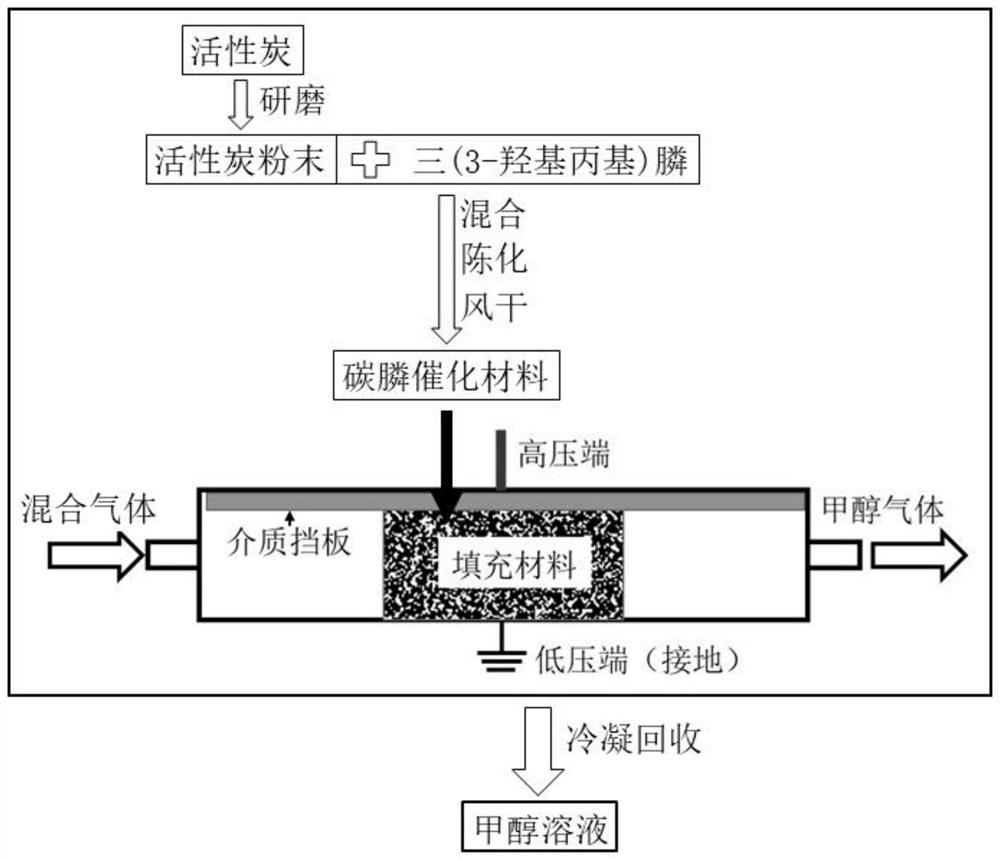Method for rapidly converting formaldehyde into methanol
A fast, methanol-based technology, applied in chemical instruments and methods, separation methods, preparation of organic compounds, etc., can solve problems such as secondary pollution, non-compliance with the green development trend of carbon sequestration and emission reduction, and adsorption performance of limited materials, etc., to achieve The effect of simple manufacturing process
- Summary
- Abstract
- Description
- Claims
- Application Information
AI Technical Summary
Problems solved by technology
Method used
Image
Examples
Embodiment 1
[0018] Example 1 The Effect of Activated Carbon Powder and Tris(3-Hydroxypropyl)phosphine Solid-to-Liquid Ratio on Formaldehyde Conversion
[0019] The activated carbon is ground and passed through a 200-mesh sieve to obtain activated carbon powder. According to the solid-liquid ratio of activated carbon powder and tris(3-hydroxypropyl)phosphine 0.25:1mg / mL, 0.35:1mg / mL, 0.45:1mg / mL, 0.5:1mg / mL, 1.0:1mg / mL, 1.5:1mg / mL mL, 1.55:1mg / mL, 1.65:1mg / mL, 1.75:1mg / mL respectively weigh activated carbon powder and tris(3-hydroxypropyl)phosphine, mix, age for 12 hours, and air-dry to obtain nine groups of carbon phosphine catalytic materials . Nine groups of carbon phosphine catalytic materials are filled between the dielectric baffle plate and the low-voltage electrode plate of the low-temperature plasma processor as filling materials, and then argon gas is passed into the polytetrafluoroethylene reaction tank for 5 minutes, and then formaldehyde gas, hydrogen gas, Argon mixed gas is...
Embodiment 2
[0031] Embodiment 2 The influence of formaldehyde gas, hydrogen, argon volume ratio on formaldehyde conversion
[0032]The activated carbon is ground and passed through a 300-mesh sieve to obtain activated carbon powder. According to the solid-to-liquid ratio of activated carbon powder and tris(3-hydroxypropyl)phosphine 1.5:1 mg / mL, respectively weigh activated carbon powder and tris(3-hydroxypropyl)phosphine, mix, age for 24 hours, and air-dry to obtain carbon phosphine catalyst Material. The carbon phosphine catalytic material is filled between the dielectric baffle plate and the low-voltage electrode of the low-temperature plasma processor as a filling material, and then argon gas is passed into the polytetrafluoroethylene reaction tank for 10 minutes, and then formaldehyde gas, hydrogen gas, and argon gas are passed through The mixed gas is irradiated with low-temperature plasma at the same time, and the gas filled with the carbon phosphine catalytic material is recovered...
Embodiment 3
[0037] Example 3 Effect of low-temperature plasma irradiation voltage on formaldehyde conversion
[0038] The activated carbon is ground and passed through a 400-mesh sieve to obtain activated carbon powder. According to the solid-to-liquid ratio of activated carbon powder and tris(3-hydroxypropyl)phosphine 1.5:1mg / mL, respectively weigh activated carbon powder and tris(3-hydroxypropyl)phosphine, mix, age for 36 hours, and air-dry to obtain carbon phosphine catalyst Material. The carbon phosphine catalytic material is filled between the dielectric baffle plate and the low-voltage electrode of the low-temperature plasma processor as a filling material, and then argon gas is passed into the polytetrafluoroethylene reaction tank for 15 minutes, and then formaldehyde gas, hydrogen gas, and argon gas are passed into The mixed gas is irradiated with low-temperature plasma at the same time, and the gas filled with carbon-phosphine catalytic materials is recovered by condensation to ...
PUM
 Login to View More
Login to View More Abstract
Description
Claims
Application Information
 Login to View More
Login to View More - R&D Engineer
- R&D Manager
- IP Professional
- Industry Leading Data Capabilities
- Powerful AI technology
- Patent DNA Extraction
Browse by: Latest US Patents, China's latest patents, Technical Efficacy Thesaurus, Application Domain, Technology Topic, Popular Technical Reports.
© 2024 PatSnap. All rights reserved.Legal|Privacy policy|Modern Slavery Act Transparency Statement|Sitemap|About US| Contact US: help@patsnap.com










